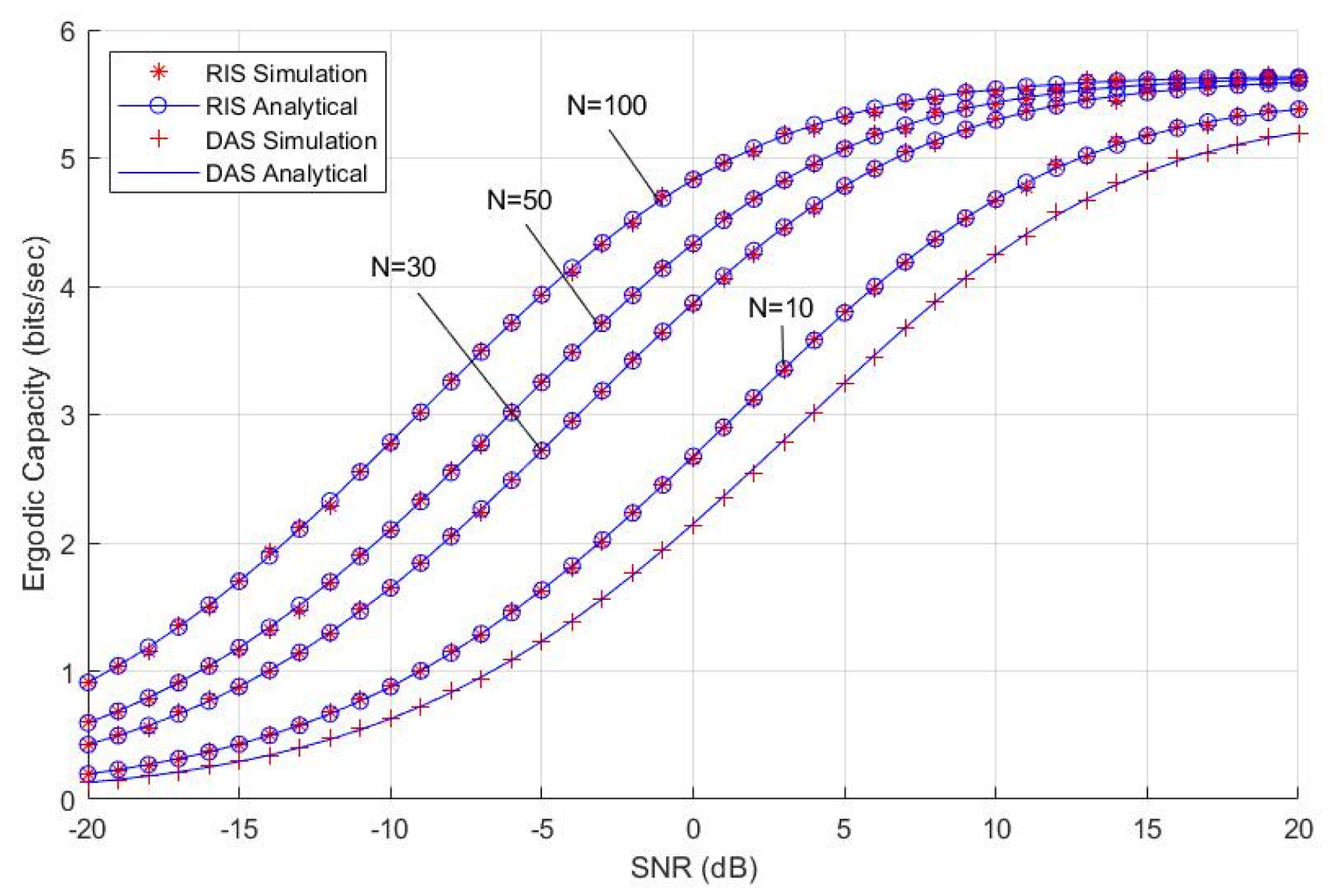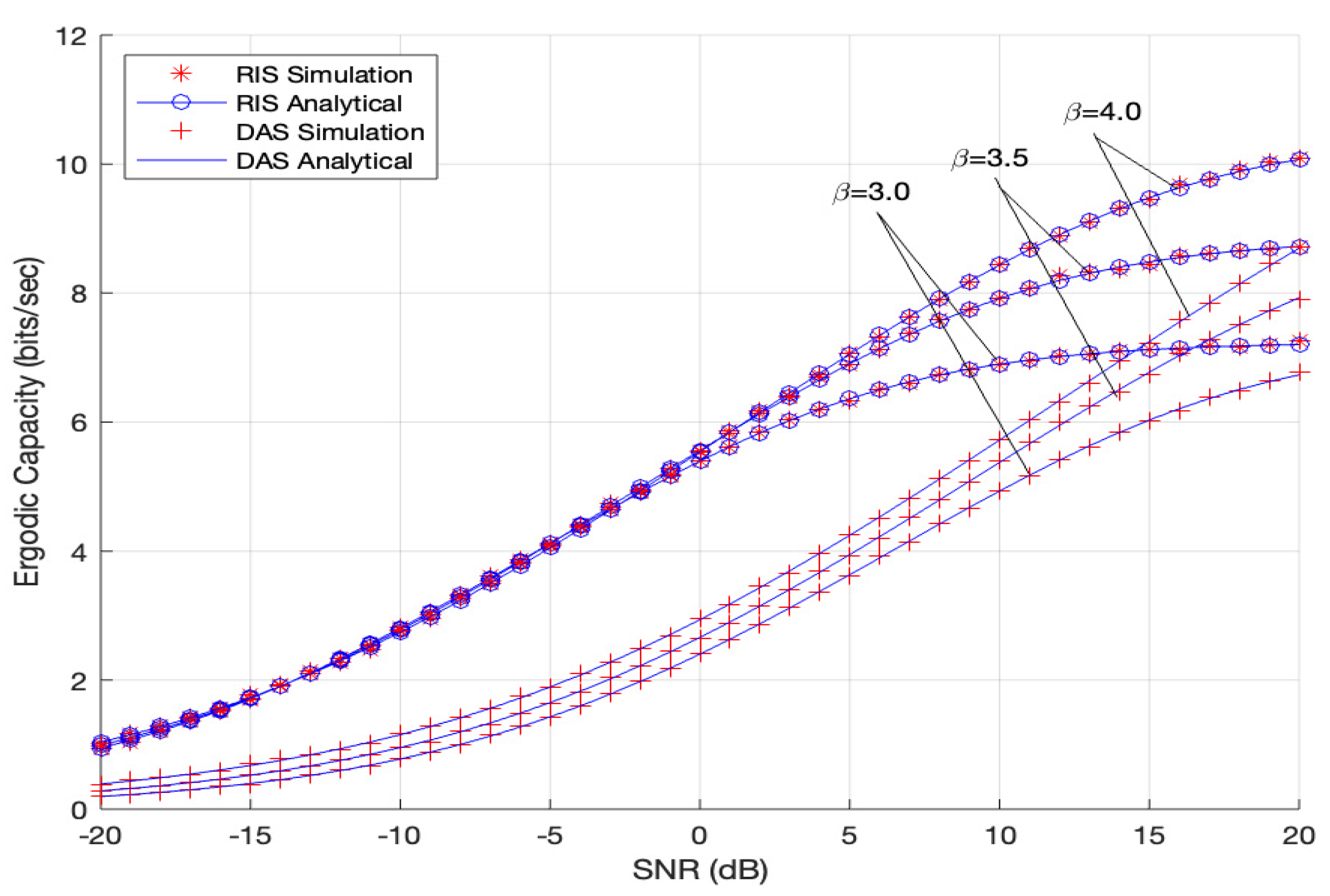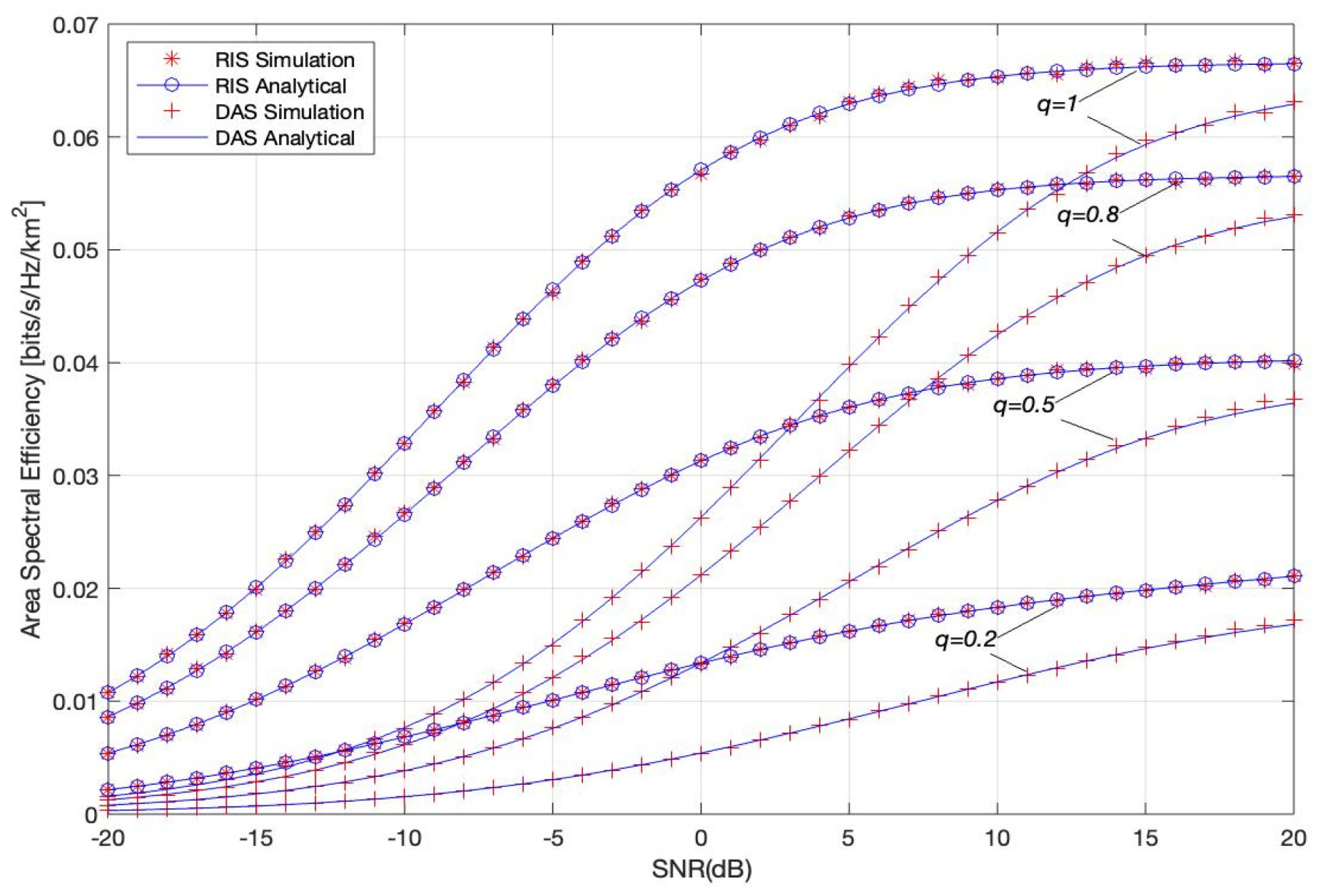Performance Evaluation of Reconfigurable Intelligent Surface against Distributed Antenna System at the Cell Edge
Abstract
:1. Introduction
- Analysis of ergodic capacity and EE for the downlink signal received by mobile users in the RIS- and DAS-aided cellular system in the Nakagami-m fading channel, with the presence of path-loss attenuation and interference from the co-channel BSs.
- We simplify the expression of ergodic capacity for both system by utilizing the moment-generating function (MGF) in order to provide the expectation of the RV and reduce the integration number of the expressed formula.
- Application of RIS and DAS at the cell edge in a fractional frequency reuse cellular system, whereby the effect of the frequency reuse factor (FRF) for the cell edge is analyzed utilizing the ASE.
2. System Model
2.1. Reconfigurable Intelligent Surface System Model
2.2. Distributed Antenna System (DAS) System Model
3. Numerical and Simulation Results
4. Conclusions
Author Contributions
Funding
Institutional Review Board Statement
Informed Consent Statement
Data Availability Statement
Conflicts of Interest
References
- Dajer, M.; Ma, Z.; Piazzi, L.; Prasad, N.; Qi, X.; Sheen, B.; Yang, J.; Yue, G. Reconfigurable intelligent surface: Design the Channel—A new opportunity for future wireless networks. Digit. Commun. Netw. 2021, 8, 87–104. [Google Scholar] [CrossRef]
- Vaca-Rubio, C.J.; Ramirez-Espinosa, P.; Jess Williams, R.; Kansanen, K.; Tan, Z.; De Carvalho, E.; Popovski, P. A primer on large intelligent surface (LIS) for wireless sensing in an industrial setting. In Lecture Notes of the Institute for Computer Sciences, Social Informatics and Telecommunications Engineering; Springer: Berlin/Heidelberg, Germany, 2021; pp. 126–138. [Google Scholar]
- Hu, S.; Rusek, F.; Edfors, O. Beyond Massive MIMO: The Potential of Positioning with Large Intelligent Surfaces. IEEE Trans. Signal Process. 2018, 66, 1761–1774. [Google Scholar] [CrossRef] [Green Version]
- Mishra, D.; Johansson, H. Channel Estimation and Low-complexity Beamforming Design for Passive Intelligent Surface Assisted MISO Wireless Energy Transfer. In Proceedings of the ICASSP 2019—2019 IEEE International Conference on Acoustics, Speech and Signal Processing (ICASSP), Brighton, UK, 12–17 May 2019. [Google Scholar]
- Basar, E.; di Renzo, M.; de Rosny, J.; Debbah, M.; Alouini, M.-S.; Zhang, R. Wireless Communications Through Reconfigurable Intelligent Surfaces. IEEE Access 2019, 7, 116753–116773. [Google Scholar] [CrossRef]
- Makarfi, A.U.; Rabie, K.M.; Kaiwartya, O.; Badarneh, O.S.; Li, X.; Kharel, R. Reconfigurable Intelligent Surface Enabled IoT Networks in Generalized Fading Channels. In Proceedings of the ICC 2020—2020 IEEE International Conference on Communications (ICC), Dublin, Ireland, 7–11 June 2020. [Google Scholar]
- Xie, H.; Xu, J.; Liu, Y.-F. Max-Min Fairness in IRS-Aided Multi-Cell MISO Systems via Joint Transmit and Reflective Beamforming. IEEE Trans. Wirel. Commun. 2020, 20, 1379–1393. [Google Scholar] [CrossRef]
- Makarfi, A.U.; Kharel, R.; Rabie, K.M.; Kaiwartya, O.; Li, X.; Do, D.-T. Reconfigurable Intelligent Surfaces based Cognitive Radio Networks. In Proceedings of the IEEE Wireless Communications and Networking Conference Workshops (WCNCW), Nanjing, China, 20–29 March 2021. [Google Scholar]
- Yang, L.; Li, P.; Yang, Y.; Li, S.; Trigui, I.; Ma, R. Performance Analysis of RIS-Aided Networks with Co-Channel Interference. IEEE Commun. Lett. 2022, 26, 49–53. [Google Scholar] [CrossRef]
- Du, L.; Ma, J.; Liang, Q.; Li, C.; Tang, Y. Capacity Characterization for Reconfigurable Intelligent Surfaces Assisted Wireless Communications with Interferer. IEEE Trans. Commun. 2022, 70, 1546–1558. [Google Scholar] [CrossRef]
- Huang, C.; Zappone, A.; Alexandropoulos, G.C.; Debbah, M.; Yuen, C. Reconfigurable Intelligent Surfaces for Energy Efficiency in Wireless Communication. IEEE Trans. Wirel. Commun. 2019, 18, 4157–4170. [Google Scholar] [CrossRef] [Green Version]
- Aldosari, M.M.; Hamdi, K.A. Energy Efficiency of Distributed Antenna Systems Using Fractional Frequency Reuse. IEEE Commun. Lett. 2015, 19, 1985–1988. [Google Scholar] [CrossRef]
- Gradshteyn, L.; Rhyzik, I. Table of Integrals, Series and Products, 7th ed.; Academic Press: Cambridge, MA, USA, 2007. [Google Scholar]
- Mahmud, A.; Lin, Z.; Hamdi, K.A. On the energy efficiency of fractional frequency reuse techniques. In Proceedings of the 2014 IEEE Wireless Communications and Networking Conference (WCNC), Istanbul, Turkey, 6–9 April 2014. [Google Scholar]
- Mahmud, A.; Hamdi, K. A unified framework for the analysis of fractional frequency reuse techniques. IEEE Trans. Commun. 2014, 62, 3692–3705. [Google Scholar] [CrossRef]
- Abramowitz, M.; Stegun, I.A. Handbook of Mathematical Functions with Formulas, Graphs, and Mathematical Tables, 10th ed.; Dover: New York, NY, USA, 1964; ninth dover printing. [Google Scholar]
- Kamel, M.; Hamouda, W.; Youssef, A. Ultra-Dense Networks: A Survey. IEEE Commun. Surv. Tutor. 2016, 18, 2522–2545. [Google Scholar] [CrossRef]
- Alammari, A.A.; Sharique, M.; Moinuddin, A.A. User-Centric Cell-Free and Co-Located Cellular Large Scale MU-MIMO Systems: A Comparative Performance Study with Spatial Channel Correlation in Dense Urban Scenario. IEEE Access 2022, 10, 48792–48809. [Google Scholar] [CrossRef]
- Liu, Z.; Dai, L. A Comparative Study of Downlink MIMO Cellular Networks with Co-Located and Distributed Base-Station Antennas. IEEE Trans. Wireless Commun. 2014, 13, 6259–6274. [Google Scholar] [CrossRef] [Green Version]
- Wang, J.; Dai, L. Downlink Rate Analysis for Virtual-Cell Based Large-Scale Distributed Antenna Systems. IEEE Trans. Wireless Commun. 2016, 15, 1998–2011. [Google Scholar] [CrossRef] [Green Version]
- You, L.; Xiong, J.; Ng, D.W.K.; Yuen, C.; Wang, W.; Gao, X. Energy Efficiency and Spectral Efficiency Tradeoff in RIS-Aided Multiuser MIMO Uplink Transmission. IEEE Trans. Signal Process. 2021, 69, 1407–1421. [Google Scholar] [CrossRef]







| Parameter | Value |
|---|---|
| Radius, R | 3 km |
| Number of co-channel cell, M | 6 |
| Number of RIS/DAS per cell, C | 6 |
| Transmit power, PT | 1 W |
| Static BS power, PBS | 7.9843 W |
| Static RIS element power, Pn(b) | 6.0 mW |
| Number of RIS element, N | 10 until 100 |
| Power amplifier efficiency, τ | 38% |
| Dynamic power consumption per unit throughput, ε | 0.1 W/bps |
| Nakagami index, m | 1 |
| Path loss exponent, β | 2.5 |
| Activity factor, q | 0.1 to 1 |
| Cell edge FRF | 3 |
| SNR | −20 dB to 20 dB |
Publisher’s Note: MDPI stays neutral with regard to jurisdictional claims in published maps and institutional affiliations. |
© 2022 by the authors. Licensee MDPI, Basel, Switzerland. This article is an open access article distributed under the terms and conditions of the Creative Commons Attribution (CC BY) license (https://creativecommons.org/licenses/by/4.0/).
Share and Cite
Kamaruddin, N.A.; Mahmud, A.; Alias, M.Y.B.; Abd Aziz, A.; Yaakob, S. Performance Evaluation of Reconfigurable Intelligent Surface against Distributed Antenna System at the Cell Edge. Electronics 2022, 11, 2376. https://doi.org/10.3390/electronics11152376
Kamaruddin NA, Mahmud A, Alias MYB, Abd Aziz A, Yaakob S. Performance Evaluation of Reconfigurable Intelligent Surface against Distributed Antenna System at the Cell Edge. Electronics. 2022; 11(15):2376. https://doi.org/10.3390/electronics11152376
Chicago/Turabian StyleKamaruddin, Nuraqila Alini, Azwan Mahmud, Mohamad Yusoff Bin Alias, Azlan Abd Aziz, and Syamsuri Yaakob. 2022. "Performance Evaluation of Reconfigurable Intelligent Surface against Distributed Antenna System at the Cell Edge" Electronics 11, no. 15: 2376. https://doi.org/10.3390/electronics11152376
APA StyleKamaruddin, N. A., Mahmud, A., Alias, M. Y. B., Abd Aziz, A., & Yaakob, S. (2022). Performance Evaluation of Reconfigurable Intelligent Surface against Distributed Antenna System at the Cell Edge. Electronics, 11(15), 2376. https://doi.org/10.3390/electronics11152376






